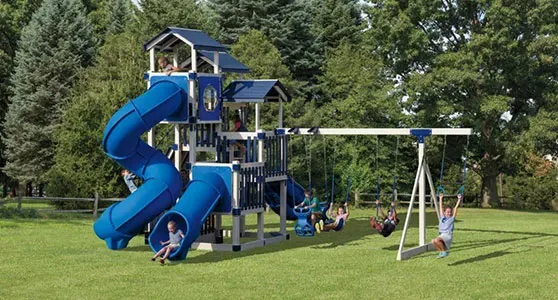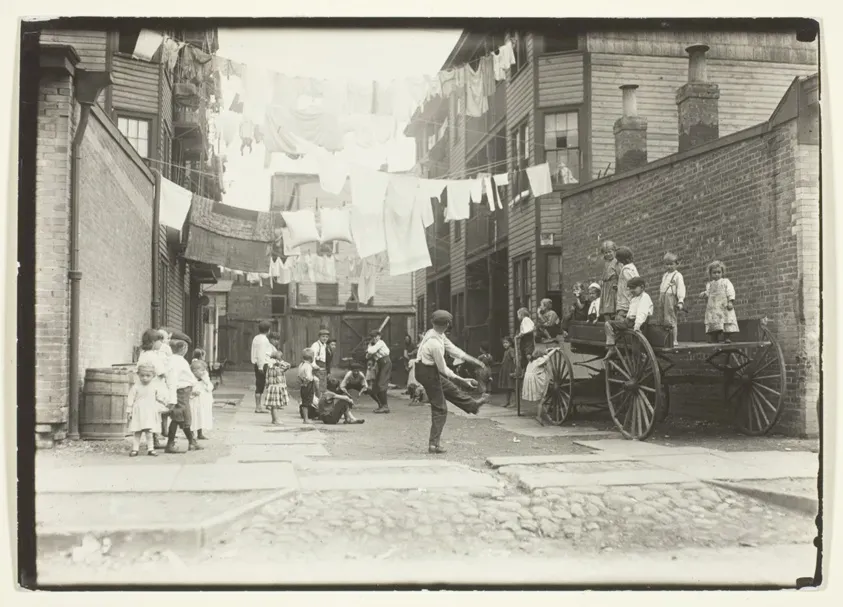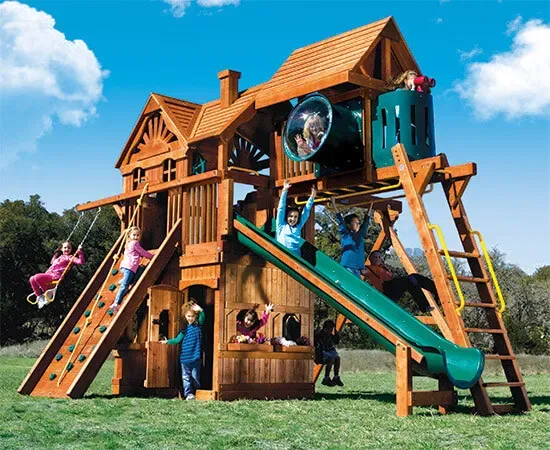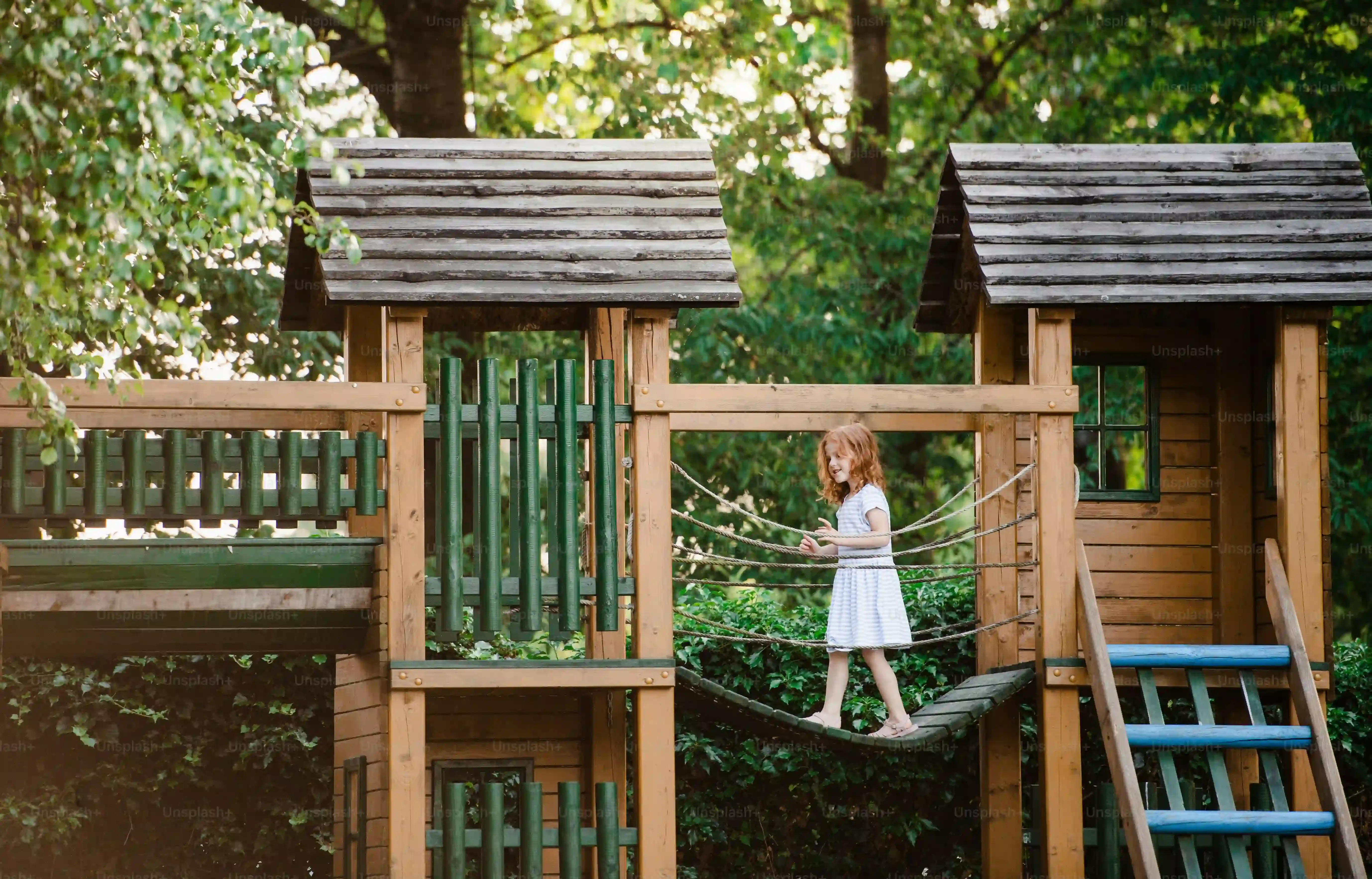Table of Contents
Let's be honest. Getting kids away from screens sometimes feels like trying to herd cats through a car wash. You suggest "outside time," and you're met with blank stares or dramatic sighs. But what if "outside" meant something truly epic? Something that sparks genuine excitement? That's where a huge backyard playground comes in. It’s not just a swing set; it’s a launchpad for adventure, a castle, a pirate ship, a place where scraped knees build character and imagination runs wilder than your neighbor's dog.
Why a Huge Backyard Playground Beats Screen Time

Why a Huge Backyard Playground Beats Screen Time
Let's just lay it out there: screens are everywhere. Kids stare at them at school, at home, in the car. Their little thumbs are getting more exercise than their legs. This is precisely Why a Huge Backyard Playground Beats Screen Time every single time. Instead of passively consuming digital pixels, they're actively climbing, swinging, sliding, and running. They're building physical strength and coordination, figuring out how to navigate space, and maybe even negotiating turn-taking with a sibling or friend without resorting to an emoji battle. It's about real-world interaction, problem-solving, and the simple, undeniable joy of moving your body outside.
Choosing Your Huge Backyard Playground: Size and Features

Choosing Your Huge Backyard Playground: Size and Features
Figuring Out How Much Space You Actually Have
Alright, let's talk real estate. You're dreaming of a huge backyard playground, maybe one with slides that twist like a pretzel and swings that reach for the sky. But before you click "add to cart" on the biggest monstrosity you find, you need to measure your yard. Seriously. Get a tape measure, not just a hopeful glance out the window. These things take up serious square footage, and you need more than just the footprint of the structure itself. Think about the safety zone – that's the area around the playset where kids might fall or swing out. Industry standards typically recommend at least six feet of clear space on all sides, and even more at the end of slides. A 25' x 25' area is often the bare minimum for anything truly substantial. If your yard is smaller, that epic multi-deck fort with a bridge and monkey bars might just be a pipe dream, or at least require a serious pruning of your expectations (and maybe some trees).
Picking the Bells, Whistles, and Climbing Walls
Once you know the rough size constraints, the fun part (and potentially wallet-draining part) begins: features. A huge backyard playground isn't just swings anymore. We're talking rock walls, cargo nets, multiple slides (tube, wave, spiral – oh my!), lookout towers, picnic tables built underneath, sandboxes, even steering wheels and telescopes for imaginative play. Consider the ages of the kids who will be using it. Toddlers need different things than teenagers. A super tall slide might thrill a ten-year-old but terrify a three-year-old. A good huge backyard playground often grows with the kids, offering challenges for different age groups. Do you want something classic and simple, or a full-blown adventure complex? Think about what activities your kids genuinely enjoy and what will keep them engaged for years, not just a few weeks.
Here's a quick list of features commonly found on larger playsets:
- Multiple swing types (belt, tire, glider)
- Slides (wave, tube, spiral)
- Climbing walls or rock holds
- Monkey bars or overhead ladders
- Forts or towers with roofs
- Sandboxes or play areas
- Picnic tables or benches
- Fireman's poles
- Access ladders or staircases
Safety First: Making Your Huge Backyard Playground Secure

Safety First: Making Your Huge Backyard Playground Secure
Built Like a Tank, But Softer Where It Counts
so you've picked out a monster playset. It's got towers, it's got bridges, maybe even a zip line if you're feeling ambitious (and have the space). But a huge backyard playground is only great if nobody ends up with a broken arm. Safety isn't the most thrilling topic, but it's non-negotiable. Think about the materials. Solid cedar construction, like some of the good ones use, splinters way less than cheaper stuff. Look for things like vinyl-dipped swing chains – they prevent pinched fingers. Handholds should be plentiful and easy for little hands to grip. Edges should be rounded, bolts should be recessed, and there shouldn't be any gaps where a head or limb could get stuck. This isn't the place to cut corners. You want something sturdy enough to handle a stampede of ten-year-olds, but designed with enough common sense to keep them from unnecessary trips to the ER.
Landing Softly: The Crucial Ground Cover
Even with the safest structure, kids fall. It's a law of nature, right up there with "cookies disappear mysteriously" and "laundry multiplies in the hamper." The ground surface beneath and around your huge backyard playground is your last line of defense against serious injury. Grass is not enough. Concrete? Absolutely not, unless you enjoy high medical bills. You need a shock-absorbing material. Think wood mulch, rubber mulch, sand, or engineered wood fiber. These need to be installed to a sufficient depth – usually at least 9 to 12 inches, depending on the height of the play equipment. And you need to maintain it, raking it to keep the depth even, especially under swings and at the bottom of slides where impact is most likely. A safe landing surface takes that energy from a fall and dissipates it, rather than letting your kid's body absorb the shock.
What's the best ground cover for a huge backyard playground?
- Engineered Wood Fiber (EWF): Often used in public parks, compacts well but needs periodic raking.
- Rubber Mulch: Made from recycled tires, excellent shock absorption, doesn't decompose, but can get hot and has a distinct smell.
- Sand: Relatively inexpensive, good shock absorption if deep enough, but can hide debris and cats might think it's a giant litter box.
- Wood Mulch/Chips: Natural look, less expensive initially, but decomposes and needs topping up, also can attract insects.
Designing Your Dream Huge Backyard Playground Layout

Designing Your Dream Huge Backyard Playground Layout
Plotting Your Playset Paradise
So, you've measured the yard, you've got a playset in mind, and you've thought about safety surfacing. Now comes the fun part that requires a bit of foresight: laying it all out. Don't just plop that huge backyard playground down anywhere the truck can park. Think about the sun. Do you want the slides facing south so they turn into a molten plastic death trap by noon? Probably not. Consider where you'll be watching from – the deck, the kitchen window? You want clear sight lines to supervise the chaos. Also, think about traffic patterns in your yard. You don't want the main path to the grill running directly through the swing zone. Sketch it out. Seriously, grab some graph paper or even just a napkin. Draw your yard shape, mark the house, the fence, big trees, anything permanent. Then start placing the playset footprint and that crucial safety zone. It’s like playing Tetris, but with higher stakes and potentially fewer straight edges.
Think about the flow. Do the monkey bars lead naturally to the slide? Is the climbing wall positioned so kids don't have to run around the entire structure to get to it? A well-designed layout makes the huge backyard playground more intuitive and safer to use. You're creating a mini-ecosystem of play. Consider access points – where do kids get onto the structure? Make sure those areas have ample clear space. If you have different levels or towers, think about how kids move between them. Ladders, stairs, climbing nets – they all need room. Don't forget about future plans either. Are you putting in a pool next year? Maybe don't put the playset right where the pool goes. Seems obvious, but you'd be surprised.
Arranging the Play Zones
Within your huge backyard playground, you often have distinct play zones: the swing area, the slide exit, the climbing section, the fort/deck space. When designing the layout, consider how these zones interact. Swings need a lot of front-to-back clearance, so make sure nothing important (or breakable) is directly in their path. The bottom of a slide is a high-traffic zone where kids land and then need to move away quickly; keep that exit clear. Climbing areas need plenty of space in front for kids to approach and potentially fall backward before they get high up. The fort or deck area is usually the central hub; ensure easy access from various points. If you have multiple structures or add-ons, like a separate sandbox or a small playhouse, place them logically near the main huge backyard playground but with their own safety clearances.
Here’s a look at typical safety clearances needed around common playset components:
Play Component | Minimum Safety Clearance |
|---|---|
Swings (each side) | 6 feet (front and back clearance needed is often double the height of the swing set) |
Slides (at exit) | 6 feet |
Climbing Walls/Nets | 6 feet in front |
Fort/Deck Edges | 6 feet |
Installation and Keeping Your Huge Backyard Playground Great

Installation and Keeping Your Huge Backyard Playground Great
Getting That Beast Built: DIY or Call in the Cavalry?
the boxes have arrived. They're big. Like, really big. You're staring at a mountain of lumber, hardware, and instructions that look suspiciously like ancient hieroglyphs. This is the moment of truth for installing your huge backyard playground. You've got two main paths: go it alone (DIY) or hire professionals. Going DIY can save money, sure, but prepare for a significant time commitment, potential frustration, and maybe a few arguments if you enlist family help. You'll need tools you might not own, like a post hole digger, a level the size of a small car, and the patience of a saint. Following the instructions precisely is critical; one misplaced bolt or wobbly joint compromises the whole structure's integrity. It's doable, but it's not a weekend project unless you have a crew of experienced builders and a lot of caffeine.
Hiring professional installers costs extra, no doubt about it. But they do this for a living. They have the tools, the experience, and they can usually assemble even the most complex huge backyard playground in a fraction of the time it would take an amateur. They know the tricks for getting everything plumb and square, and they can handle unexpected issues, like hitting a buried rock the size of a Volkswagen. Plus, many companies offer warranties that might be tied to professional installation. It's a trade-off between cost and convenience, and frankly, sometimes paying someone else to wrestle with hundreds of pieces of wood and hardware is money well spent for your sanity.
Keeping It Shipshape: Maintenance is Not Optional
So, it's built. The kids are swinging, sliding, and generally wearing themselves out – mission accomplished! But your job isn't over. A huge backyard playground isn't a "set it and forget it" kind of deal. It sits outside 24/7, exposed to sun, rain, snow, and whatever else the sky decides to drop on it. Wood needs sealing or staining periodically to prevent rot and splintering. Hardware needs to be checked and tightened regularly; bolts vibrate loose over time, especially on high-use components like swings. Look for cracks, splinters, or signs of insect damage. Check ropes and chains for wear and tear. Make sure the ground surface is still adequate – rake and replenish mulch or sand as needed.
Ignoring maintenance on a huge backyard playground isn't just about aesthetics; it's a safety issue. A loose bolt can cause a collapse. A rotten board can break. Worn swing chains can snap. A quick inspection every month or two, and a more thorough one at the beginning and end of the play season, can catch small problems before they become big, dangerous ones. Think of it like owning a car; ignore the oil changes and weird noises, and eventually, you're stranded. Ignore playset maintenance, and someone might end up with more than just a scraped knee.
What should you check during a routine huge backyard playground inspection?
- Tightness of all bolts and nuts.
- Condition of wood (splinters, cracks, rot).
- Wear on ropes, chains, and swing hangers.
- Stability of the overall structure.
- Depth and coverage of protective ground surfacing.
- Clearance area around all components.
- Rust or corrosion on metal parts.
More Than Just Wood and Plastic
So, you've navigated the lumberyards, wrestled with instructions that looked suspiciously like ancient hieroglyphs, and possibly questioned your sanity more than once. But now, standing there, is your huge backyard playground. It's not a magical cure for every childhood ailment, and yes, someone will still complain about something eventually. But look closer. It's a place where stories are invented on the fly, where physical limits are tested and sometimes exceeded (usually resulting in a brief timeout), and where the simple act of swinging can somehow solve complex sibling disputes. It's an investment, sure, but one measured not just in dollars, but in hours of actual, non-digital childhood.